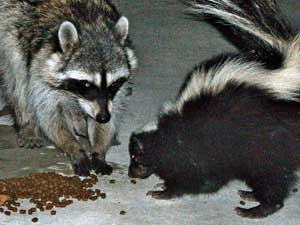My brother is a carpenter in North Carolina. In this economy, work has been dreadfully slow. He decided to take an afternoon to go for what he thought would be a relaxing walk in the woods. He and his Labrador Retriever Zeke headed out for some trails near his house.
 |
A raccoon and skunk feast on cat food left out in a backyard. Both species could potentially carry rabies. Do not leave pet food or garbage outside where it can attract animals. Do not handle wild animals. Avoid stray dogs or cats. Keep your own pets vaccinated. If you are bitten, immediately consult with a doctor, hospital or health department. The recommended deadline for rabies shots is 10 days after exposure, but sooner is safer. Wikimedia Commons photo. |
After about ten minutes, Zeke suddenly took off. John saw him dive into a deep thicket. A fight ensued. Zeke emerged with a medium-sized raccoon in his mouth. The captive was emitting a high-pitched squeal. John yelled at the dog to drop it. Zeke declined and tore off down the trail.
John followed and eventually found the dog. Just then, a passerby mentioned there was a dead raccoon further on. John found the body a couple hundred yards away. Zeke had never killed an animal before.
John picked the body up and whipped it into the woods so no one else’s dog would get into it. Both he and Zeke got blood and saliva on them. As soon as he got home, John gave the dog a thorough cleaning. He noticed Zeke had pulled a dew claw during the struggle, and called the vet.
The vet said the raccoon was probably rabid. John didn’t think that was likely since “It was just about the prettiest raccoon I’ve ever seen in my life. It had no visible signs of illness - otherwise I never would have touched it.” When John mentioned that he knew where the raccoon was, the vet said he needed to get it tested. My mother concurred.
John went back and retrieved the raccoon. He called the local animal control agency, who came out and picked up the body that afternoon. The next morning they called to tell John that sure enough, the raccoon was rabid.
“Everybody thinks rabid animals will look mangy or be foaming at the mouth,” said John. Actually, that stage doesn’t happen until a few days before they die. Although John was advised that the odds of contracting rabies were quite low, he might have had some small open cuts on his hands, and had also wiped his face off after the incident. Immediately washing bites or cuts with soap and water greatly reduces the chances of infection, but there is still a risk – and the results are fatal. If you are bitten or get the saliva of a rabid animal on an open cut, you need treatment – period.
John was treated. It was covered by insurance after a $150 deductible, and fortunately they no longer require painful shots to the stomach. My brother did say the first immune globulin shot was pretty uncomfortable, but figured it was better than a long, slow, painful death. The initial treatment was followed by a series of four shots of vaccine, one each week, which he said did not hurt more than any other shot. The dog was up to date on his rabies shots, but was required to get a booster shot with 72 hours of the encounter, to be on the safe side.
In October of this year, a 74 year old woman in central Florida heard a noise outside her house, and saw raccoons in her back yard. When she opened the door to wave them away, the gang of five attacked. As they bit and scratched her legs, she fell down. A neighbor heard her screams and rushed over to help and the raccoons took off. The local sheriff said “While we don’t know if there has been an actual exposure, we just can’t take that chance,” so the victim was treated.
The problem with rabies is that an animal can be infected but initially show no signs of illness. The incubation period is 3-12 weeks, during which it may be restless, disoriented or fearless. Once the virus reaches the brain, the host always dies, usually within a week.
Only mammals can get rabies, and it is only transmitted via saliva. Raccoons, skunks, bats and foxes are the most likely carriers. Rabies is occasionally seen in coyotes and even otters. Rodents are almost never infected, but there have been some cases involving woodchucks. Rabies is rare in the U.S., but it is still a threat. In 2005, a rabid stray cat was found in Pomfret CT. That same year, a man was attacked by a rabid bobcat that got into his parents cellar in Litchfield CT. If you, your pet or a domestic animal are bitten by a mammal, immediately seek medical advice. You don’t want to end up like Old Yeller. |

